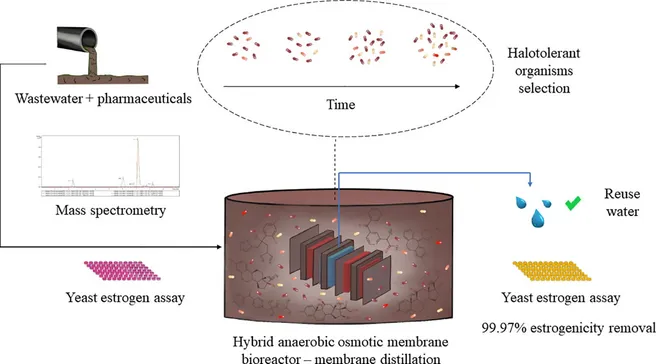Pharmaceutically active compounds (PhACs) may cause harmful effects in living beings, and advanced treatment is required to improve wastewater treatment plant efficiency. In this context, this study aimed to assess the performance of a hybrid anaerobic osmotic membrane bioreactor coupled with a membrane distillation system (AnOMBR-MD) for removing PhACs and estrogenic activity from municipal sewage. Human health and environmental risks of produced water were also assessed. The removal efficiency of dissolved organic carbon and P-PO43- reached 97.2% and 98.0%, respectively. N-NH4+ accumulated in the bioreactor since anaerobic treatment can not remove it. Salinity increase in the bioreactor caused a great change in the microbial community, with Chao 1 and Shannon indexes higher in the sludge after 50 days of operation than in the sludge used as inoculum. Estrogenic activity of municipal sewage spiked with PhACs was >3 times higher than the expected value calculated by the additive model (2 µg L−1E2-eq.), which indicates that some of the PhACs effects increased in the presence of others. Estrogenicity was not detected in distillate samples, which greatly reduced human health risks to acceptable values. Of the 7 PhACs selected in this study, only betamethasone, fluconazole, and prednisone were detected in the distillate. However, the overall removal of PhACs by the AnOMBR-MD system was higher than 96.4%. The chronic environmental risk considering the estrogenic activity was classified as high because of the detection limit in the yeast estrogen screen (YES), which supports the need for improving bioassay sensibility. The results demonstrated that the use of the YES assay combined with detection and identification of micropollutants allowed an effective assessment of the overall treatment performance.
